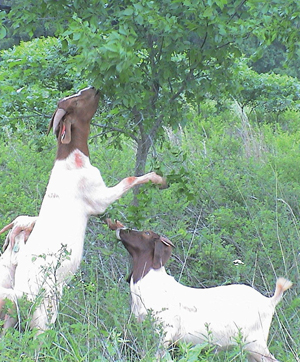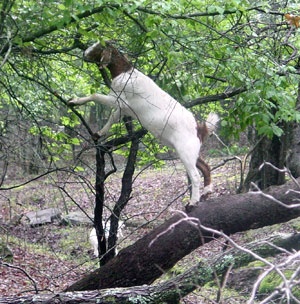
Beneficial characteristics
Several characteristics of goats make them the animal of choice for vegetation management. Goats are a low-input animal, require a minimum investment for start-up, have low expenditures for maintenance and require only a moderate level of labor for animal management. However, goats do require a high level of management knowledge. Goats have a diverse dietary preference and consume a wide variety of plants. They have very nimble lips, allowing for selection and consumption of the most nutritious components of the available biomass. Goats have a preference for browse and can consume significant amounts of forbs. They can stand on their hind legs reaching over 6 feet into browse plants. Goats tolerate higher levels of tannins than cattle or sheep and rarely bloat. In addition, they have few problems from plant toxicity as the large number of plant species consumed daily generally prevents consumption of a toxic dose of any particular one. The diet diversity of goats probably minimizes their likelihood of mineral deficiencies.
Through their grazing habits, goats reduce the production of seeds by consuming seeding stems. The immature seeds consumed do not survive passage through the digestive tract. Mature seeds may pass through the goat in the manure. Goats may reduce woody vegetation through debarking, resulting in plant death. Through digestion and the passing of feces and urine, goats release plant nutrients tied up in unwanted vegetation, making those nutrients available for other plant growth. Further, as goats make progress in controlling vegetation, ticks and snakes can be reduced due to reductions in their habitat.
A final benefit of using goats to control vegetation is that, while these animals consume undesirable plants, they are also producing a saleable product. Instead of spending between $10 and $25 per acre for chemical control, goats may provide a return of $10 to $20 per acre while controlling vegetation.
Hart, S. 2006. Goats for Vegetation Management. In: Meat Goat Production Handbook, ed. T.A. Gipson, R.C. Merkel, K. Williams, and T. Sahlu, Langston University, ISBN 1-880667-04-5.


